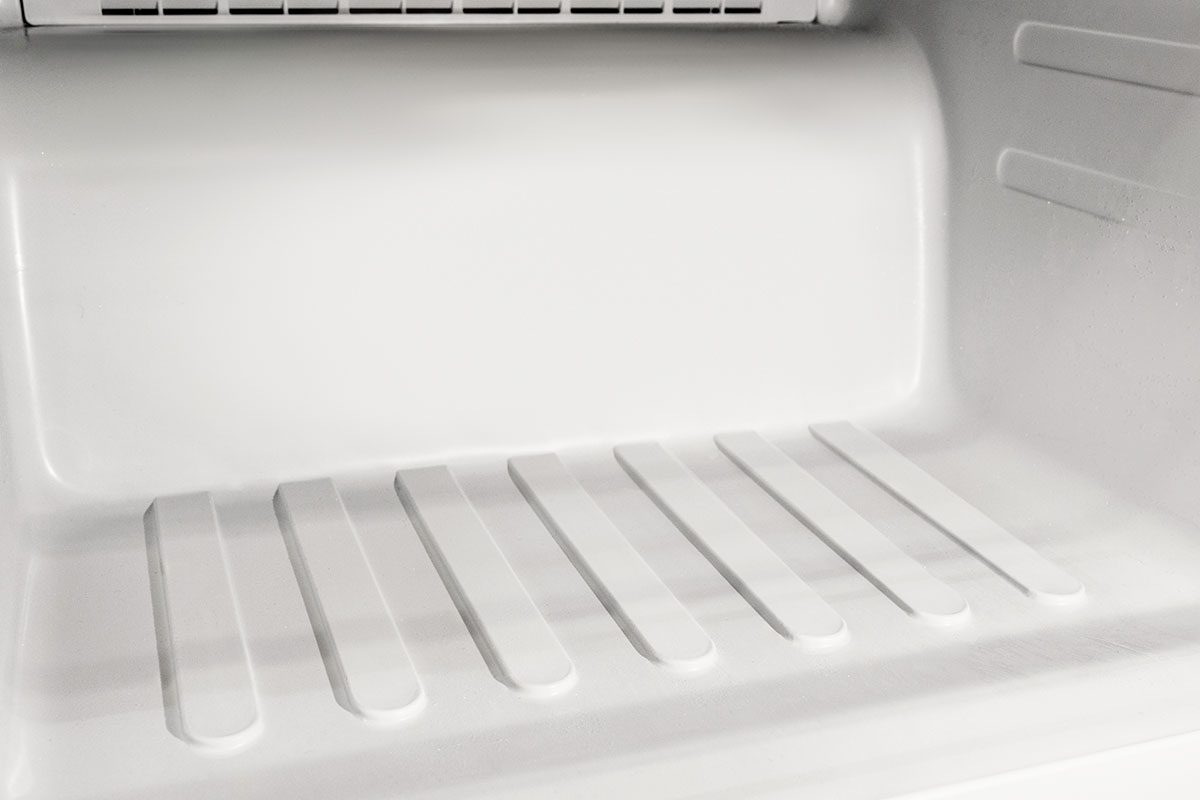Yes, this feature is in most freezers, and nope, it's not random!

Here’s Why There Are Ridges on the Bottom of Your Freezer

The next time you open the freezer to grab some frozen berries for your smoothie or, let’s be real, that brand-new bag of Costco french fries, check out the bottom of your freezer. You may have never noticed, but there’s a good chance it has grooves all along the bottom. Why, though? Shouldn’t it be flat? Or do appliance companies get some sort of perverse joy from having our chicken cutlets and boxes of frozen pizzas wobble about?
To get to the bottom of this kitchen mystery, we consulted appliance expert Forrest Webber, owner of Bear Brothers Cleaning in Huntsville, Alabama, and the online home-improvement company The Trade Table. Slight spoiler alert: In case you were wondering, yes, this feature is in most freezers, and no, it’s not random!
Read on to find out what those ridges are all about and what they mean for your frozen food.
Get Reader’s Digest’s Read Up newsletter for more common curiosities, humor, cleaning, travel, tech and fun facts all week long.
Why are there ridges on the bottom of your freezer?
“Those ridges aren’t just there for decoration or to make cleaning harder,” Webber says. “They allow air to circulate across the bottom by slightly elevating your food.”
This clever engineering feat helps your freezer maintain the just-right temperature. “By enabling moisture to move or evaporate rather than freeze in one place, this tiny area contributes to a more constant interior temperature,” he adds.
How do the ridges keep your frozen food fresh?

The uneven surface helps ensure your food stays fresh and frost-free by keeping your freezer at the perfect “Goldilocks” temperature: not too hot and not too cold. Having hot pockets, in particular, may cause food to partially thaw, which can affect the quality, according to the U.S. Department of Agriculture (USDA).
What is the problem with stacking frozen food on a flat surface?
The real issue with piling frozen foods flat against a smooth surface is “the cold air can’t reach underneath it, creating what’s essentially a ‘dead zone’ for airflow,” Webber explains. That trapped moisture eventually freezes, which “causes all kinds of headaches, like stuck packages, frost-covered veggies or freezer burn.”
It can also lead to the following problems:
Uneven freezing
“Some items may freeze rock-solid, while others are just cold but not fully frozen,” Webber says. This can affect how long food lasts in your freezer.
Frost buildup
Trapped moisture will freeze where it gets stuck—typically between the food and the freezer wall or floor, Webber says. This is especially likely to happen when you put hot items in the freezer without letting them cool off a bit first. Those ridges help mitigate this problem.
An overwhelmed freezer
When air can’t circulate properly, your freezer has to work harder to compensate. This ultimately uses extra energy and can even shorten your appliance’s lifespan, Webber says.
What should you do if a layer of ice develops in your freezer?
Whether or not your appliance has ridges, sometimes you end up with a big, old icy mess at the bottom. Whatever you do, don’t ignore it. To keep your appliance operating properly and your food as fresh as possible, it’s time to defrost your freezer and get things back on track. Here’s how.
Empty it out
Remove all food, and place it in a cooler. “Frost or condensation is a sign that something’s off with circulation or the defrost system, and you need full access to fix it,” Webber says.
Unplug the freezer
Keep the freezer door open, and turn off the freezer (which usually means you’ll also be turning off the refrigerator). It will get messy as the ice melts, so keep a big shallow basin to collect the water, or spread towels on your floor. To speed up this chore, put a dish of hot (not boiling) water in the freezer and shut the door for a while.
“Never use a knife or metal tool to chip away at the frost,” Webber warns. “It can pierce the lining or refrigerant lines.”
Remove the grime and funk
Once your freezer has thawed, use a cloth to clean the interior surfaces with a solution of warm water and baking soda. “This serves as a deodorizer, absorbing any remaining moisture while also cleaning everything,” Webber says. Wait until all surfaces are totally dry before plugging in the appliance again.
Fill it up
After restarting the freezer, wait until it reaches the ideal temperature, which is 0 degrees Fahrenheit or below, per the U.S. Food and Drug Administration (FDA). Then, restock and organize your freezer. And you might as well do some condensation prevention while you’re at it: “Instead of packing everything against the walls or floor,” Webber says, “try to leave small spaces between everything.”
Do ridges on the sides of a freezer work in the same way?

Yes, those side ridges—which usually go hand in hand with grid-style drawers—are similar to bottom ridges. “The grid design in your drawer-style freezer serves the same essential purpose as the ridges at the bottom of traditional freezers: to control airflow and maintain moisture levels.” Who knew!
Why trust us
At Reader’s Digest, we’re committed to producing high-quality content by writers with expertise and experience in their field in consultation with relevant, qualified experts. We rely on reputable primary sources, including government and professional organizations and academic institutions as well as our writers’ personal experiences where appropriate. We verify all facts and data, back them with credible sourcing and revisit them over time to ensure they remain accurate and up to date. Read more about our team, our contributors and our editorial policies.
Sources:
- Forrest Webber, owner of Bear Brothers Cleaning and The Trade Table home improvement company; email interview, April 21, 2025
- USDA: “Freezing and Food Safety”
- FDA: “Are You Storing Food Safely?”



